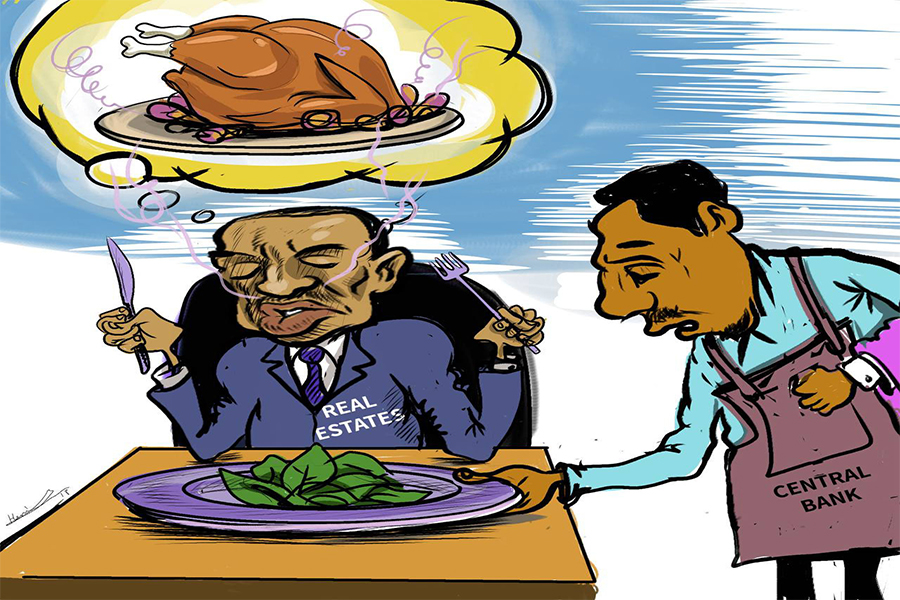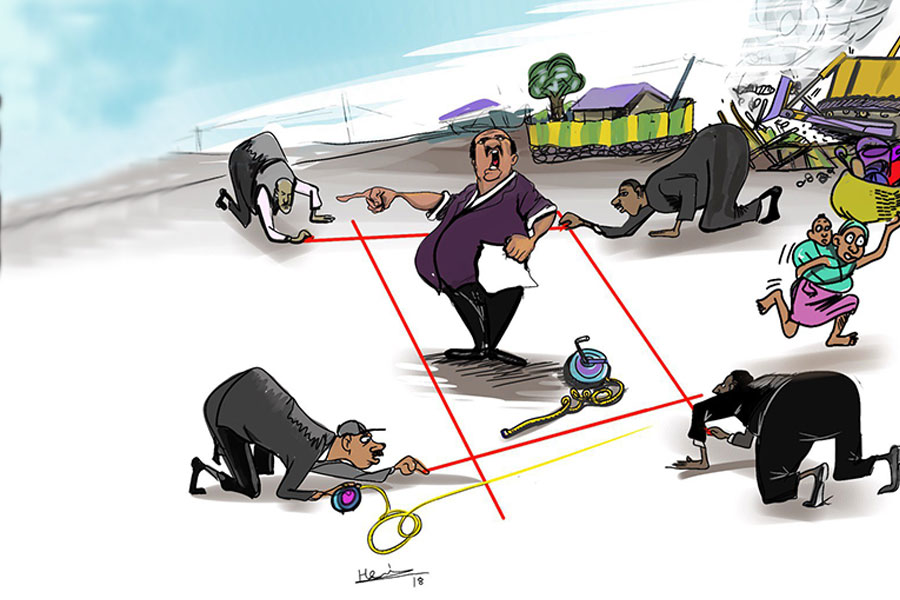
Photo Gallery | 173813 Views | May 06,2019
Oct 12 , 2025. By REDIET YARED ( FORTUNE STAFF WRITER ) , SURAFEL MULUGETA ( FORTUNE STAFF WRITER )
Urban families are adapting recipes and habits to cope. Many now blend green chillies or cabbage as a substitute for tomato sauce. With domestic tomato consumption growing three percent each year since 2017, and supply projected to fall below demand by 2026, the humble tomato now stands at the crossroads of urban diets, rural livelihoods, and national economic policy, reports REDIET YARED & SURAFEL MULUGETA, FORTUNE STAFF WRITERS.
The sun rose unsteadily over Addis Abeba last week, its pale light muted by dust and exhaust, flickering off tomato crates stacked on narrow streets in the Haile Garment neighbourhood.
For 32-year-old Semira Adem, the amber flash of ripening skins was a taunt. In better days, she took home five, even seven, kilograms at a time, simmering a weekly supply of sauce for Macaroni and Spaghetti. Now she can barely pay for two. Two weeks earlier, she bought them for 25 Br.
“Which comfortable life allows us to buy ingredients now?" she said, exhaling through clenched teeth. "It’s impossible to live.”
Retail stands ask 85 Br to 140 Br a kilo, roughly triple last year’s price. Gelila tomatoes, a premium variety, cost 90 Br a kilo. After transport, sun and rain damage, and the odd crate lost to spoilage, the margin is razor-thin. Input costs have rocketed. Most fertiliser, pesticide and seed arrive from the Netherlands, Israel and elsewhere, and the Birr’s slide against the dollar has doubled or tripled landed prices.
It is what Anwar Alewi, 36, a distributor, experiences regularly. Last week, he steered an ageing pickup through the market at dawn, buying from small plots and delivering to hotels and kiosks. He rented 86 plastic crates, each weighing about 60 kg, for 4,000 Br.
“We’re suffering too, and we’re not profiteers like people think,” he said above the clatter of handcarts.
Fuel deepens the pain. Irrigation pumps swallow diesel at 126 Br a litre; a modest plot burns 200Ltrs a day. Winter-hardy seed demands 3,500 grains per plot, four Birr each, or 28,000 Br before a field is even ploughed. Chemicals that cost 3,000 Br last year now run 8,000 Br. Seed that fetched five Birr a packet sells for up to 30 Br.
“It’s nearly a 50pc jump in a single season,” said Eshetu Bejiga, who manages the Awash Olana Irrigation Farmers’ Union.
Ashenafi Feyissa, production coordinator at the Oromia Agricultural Cooperative Federation, laid out the macro picture. The dollar rose from 58 Br to 140 Br, while lending rates crept from 12.5pc to 14pc. Almost all agrochemicals are priced in hard currency. The Federation’s catalogue lists more than 15 inputs, from herbicides and pesticides to disease control, costing 3,045 Br to 12,000 Br each.
“The burden keeps shifting to farmers and then to consumers,” he said.
Fereja Tessema, who has farmed for 27 years along the Awash River, pulled up his trellises this season and sold a few sheep to stay afloat.
“I stopped working on tomatoes because of the cost of inputs,” he said. “One quarter-hectare used to cost me 30,000 Br. Now it takes 100,000 Br to 270,000 Br.”
For other farmers, such as Solomon Ayalew, who farm outside Modjo, the math is mind-boggling. It takes more than 250,000 Br to produce one quarter-hectare.
“These factors have resulted in substantial losses for us,” he told Fortune.
A truck from Awash to Addis Abeba costs 29,000 Br, not to mention the 20,000 Br loading and unloading fee. Seed prices swing with every shipment, keeping planning close to guesswork. At the other end stands retailer Bontu Gemechu, 22, who operates a stall in the Hanamariam area, Nifas Silk District. She saves 100 Br a day to cover rent. Her freckled and bruised stock sells from 10 Br to 95 Br a kilo.
“If I've nothing to eat, I will fast,” she said, packing split fruit into plastic bags for bargain hunters.
Households respond by stretching recipes. Some mix powdered pepper with water and salt to mimic tomato sauce; others substitute cabbage. Vendors report brisk sales of cheaper green chillies, evidence that buying habits are shifting down the price ladder.
“I never thought I would cook spaghetti without tomatoes," Semira said. "But, I do it every other night now.”
Another household by Fate Tura, unemployed and raising three children, has halved its purchases. Her 17-year-old son chips in 2,000 Br toward rent while juggling military service.
“I obsess over what to buy when my kids come home,” she said.
Urbanisation, dietary diversification, and a thriving hospitality sector have driven consumption up by roughly three percent a year since 2017. Ethiopia now consumes between 25,000tns and 30,000tns of tomatoes annually, with projections forecasting continued upward pressure. Supply is not keeping pace. Without improvements in productivity and supply chain integration, output is projected to fall to 24,160tns by 2026, exacerbating the demand-supply mismatch.
Paradoxically, while domestic shortages persist, Ethiopia exported 22,810tns of fresh tomatoes in 2023, nearly two-thirds of national output, generating 11.4 million dollars. Somalia and Djibouti remain the principal buyers, leveraging geographic proximity and market integration. Additional volumes went to Nigeria, Saudi Arabia, and Kenya, the country's emergent footprint in East African horticulture.
The export momentum, while attractive, risks crowding out domestic processors and urban consumers like Semira and Fate, who now face erratic prices.
Before inflation caught fire, Anwar’s daily routine used to empty his crates by noon. These days, he hangs around until late afternoon, persuasive smile fading as customers flinch at the numbers on his scale. On weekends, he sometimes brings the unsold fruit back to wholesalers outside the city, accepting a smaller payment for produce already bruised by potholes.
“Even a small crack on the skin makes hotels reject them,” he said. “Every rejected box eats into the little profit left.”
He figured spoilage and chargebacks now wipe out nearly a third of his gross revenue.
Restaurants like Siyamrebesh Café Pizza & Restaurant feel the bite. The restaurant burns through 12Kg a day for sauces that anchor pizzas and burgers. The weekly tomato bill has tripled, slicing net profit by half from 20pc.
“We can’t serve what customers want as prices rise,” said Zena Tenker, the manager. “If this keeps up, we may close.”
Official mandatory price ceilings have done little.
“All the materials we sell follow government orders,” said Eshetu Bejiga.
The authorities blame intermediaries active in the market for inflating prices to widen their margins.
In the shadow of the more celebrated commodity exports, primarily coffee, oilseeds, and khat, tomato production is a bellwether for the horticultural prospects, which grew by five percent in 2023 to reach 36,100tns. It offered a rare glimmer of resilience in a sector long beset by volatility.
Mekonnen Solomon is the horticultural export coordinator at the Ministry of Agriculture. He observed a trend where when farmers cannot afford quality breeds, they abandon tomatoes, supply shrinks, and prices jump.
“The price of seed drives inflation," he told Fortune.
Oromia Regional State, leveraging agro-climatic advantages and relatively better irrigation infrastructure, contributes up to 60pc of national output, led by East Shewa and Arsi zones. Amhara Regional State trails distantly at around 20pc, with the Southern Nations, Nationalities and Peoples' State as well as fringe contributors like Afar and Gambela regional states marginally supplementing the balance.
After peaking at 42,000tns in 2020, a confluence of erratic rainfall, pest infestations, and a sluggish input supply chain triggered a dramatic fall to 33,600tns in 2021. The modest recovery in 2023 was less a structural turnaround than a partial correction.
Critically, post-harvest inefficiencies continue to drain producer margins. An estimated 25pc of the tomato crop is lost between field and market, casualties of inadequate storage, poor transportation infrastructure, and limited cold chain investment. Average yields, between six to nine tonnes a hectare, compare unfavourably with regional peers, let alone global standards.
Seasonality compounds the strain. Most farmers plant in January, when temperatures are mild and disease pressure is low. Diseases such as leaf spot, bacterial spot, and early blight (known locally as Wag) spread quickly as late blight races through fields between June and August.
“Early protection is critical,” said Jima Degaga, chief for quality-control of the Meki Batu Fruits & Vegetables Growers’ Cooperative Union Ltd, in Oromoa Regional State.
The Union was established in 2002, incorporating 12 primary cooperatives, with 527 members farming in Dugda and Adami Tulu Jido Kombolcha weredas, near the Dembal Lake. One of their farmers may pay 1,000 Br to 7,000 Br for fungicides such as Ranman, Neem oil or Amistar, and up to 250,000 Br for full coverage. Those who plant in January manage with cheaper insecticides like Radiator and Tresor at about 2,000 Br.
From June on, cold weather and fungi push many growers into wheat. Many growers produce over one million quintals a year. The Union sells fertiliser at set rates, but shortages send farmers to private merchants who charge 2,000 Br to 3,000 Br more per unit, according to Lencho Hamde, its director.
Some commercial outfits absorb the shock. Take Super Arsity Production, incorporated in 2004 as a flower exporter. It now spreads across 49hct in Awash Melkasa. Weather stations and disease sensors monitor fields; crop rotation covers 38pc of the acreage. The farm harvests an average of 930Qtls a year. Resistant seed brands (Gabbi, Pachuca, Galaxy and Yug) cost up to 7.50 Br each but shrug off hail. Chemicals such as Ridomil Gold, Cooper, Acrobat and Mancozeb, along with fertilisers such as urea, potassium nitrate and MAP, preserve output.
Researchers press for organic inputs.
“We ought to focus more on organic fertilisers rather than synthetic ones,” said Alemenew Tagel (PhD), a horticulture lecturer at Gonder University.
Compost and dung improve soil and trim hard-currency spending. Organic matter releases nutrients slowly, supports beneficial microbes and reduces run-off into rivers. Yet, scaling up demands extension training and reliable collection systems.
A ray of hope appeared in August, when Nigeria’s Dangote Group announced it would build a 2.5 billion dollar urea plant in Gode, Somali Regional State. Dangote will hold 60pc, with the state-owned Ethiopian Investment Holdings (EIH) taking the rest. Many hope the plant could temper fertiliser prices that now choke growers, though engineers say it will need steady electricity and rail links to reach full capacity.
Until then, growers juggle a fragile calculus of sun, soil and debt. The Federation once held 80,000Qtls of fertiliser in reserve and planned for 300,000Qtls, yet gaps persist. Private suppliers fill the void, layering costs that echo down to city buyers. Extension agents now tour villages, urging farmers to aerate soil, rotate crops and spray early.
“Exposing soil to air before sowing can cut chemical bills in half,” Jima said during a recent field day that drew dozens despite midday heat.
Weather adds another wild card. Heavy rain, hail and sudden temperature drops can wipe out a crop overnight.
“Tomato production is unstable,” Lencho said. “In comfortable months, the crop flourishes; in cold months, diseases take over.”
Farmers share photos on their phones of flattened greenhouses and drenched seedlings, evidence that even perfect management cannot tame the climate. However, demand in the capital never wanes. Tomatoes thicken "Shiro," locally made stew, brighten "Fir-Fir," and crown the burgers that fuel a swelling workforce. Each fruit carries the weight of global supply lines filtered through local bottlenecks and a battered currency.
As the sun climbed over Haile Garment, Semira counted the coins in her palm and found she could buy exactly two kilos, no more. She eased the tomatoes into a fraying plastic bag and started home across the cracked asphalt. Her hope, like that of farmers and traders up the line, is that the next harvest will bring relief, and that two kilos of tomatoes will not feel like a luxury.
PUBLISHED ON
Oct 12,2025 [ VOL
26 , NO
1328]

Photo Gallery | 173813 Views | May 06,2019

Photo Gallery | 164039 Views | Apr 26,2019

Photo Gallery | 154098 Views | Oct 06,2021

My Opinion | 136582 Views | Aug 14,2021

Oct 11 , 2025
Ladislas Farago, a roving Associated Press (AP) correspondent, arrived in Ethiopia in...

Oct 4 , 2025
Eyob Tekalegn (PhD) had been in the Governor's chair for only weeks when, on Septembe...

Sep 27 , 2025
Four years into an experiment with “shock therapy” in education, the national moo...

Sep 20 , 2025
Getachew Reda's return to the national stage was always going to stir attention. Once...